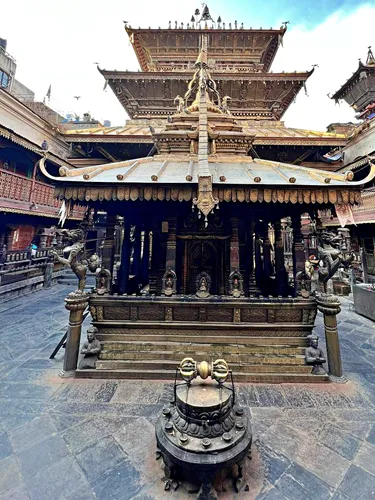Discover the Golden Temple: Hiranya Varna Mahavihar in Patan - Nepal Purple Travel Guide
(map, reviews)
This is Premium Content! To access it, please download our
Backpack and Snorkel Purple Travel GuideHiranya Varna Mahavihar is popularly known as the Golden Temple. It features a gilded façade, intricate wood and metal carvings, and two mystic lion statues in the front.




Here at Backpack and Snorkel Travel Guides, we typically promote self-guided walking tours.
But we realize that not everybody likes to walk by themselves in a foreign city. So, just in case that you rather go with ab guide: NO PROBLEM! Please see the Viator tours below.
free GuruWalk tours
paid Viator tours
Origin of the name Hiranya Varna Mahavihar
The name Hiranya Varna Mahavihar comes from Sanskrit:
Hiranya means ‘gold’
Varna means ‘color’ or ‘appearance’
Mahavihar means ‘great monastery’
Altogether, the name can be translated as the ‘Great Monastery of the Golden Color’, a direct reference to the temple’s gleaming golden exterior, which sets it apart from other traditional courtyards in the valley.
Hiranya Varna Mahavihar: A Living Monastery with Deep Roots
Believed to have been built in the 12th century, likely by King Bhaskar Varman, Hiranya Varna Mahavihar has been a vital center of Newar Vajrayana Buddhism for nearly a thousand years. Despite its age, the monastery is still active and is maintained by the local sangha (Buddhist community), which upholds a strict daily schedule of rituals, caretaking, and ceremonial duties.
Local Legend of Hiranya Varna Mahavihar
According to local legend, the location of Hiranya Varna Mahavihar was chosen because it was a spot where a rat was seen chasing a cat - a reversal of nature’s usual order.
This bizarre sight was interpreted by the spiritual leaders at the time as a powerful omen, symbolizing the reversal of karma, the overcoming of natural hierarchies, and a place where the impossible becomes possible. In Buddhist philosophy, such a phenomenon can be viewed as a manifestation of deep spiritual energy or a break in the ordinary cycle of cause and effect, hinting that the site was blessed or spiritually potent.
As a result, it was deemed an auspicious location for establishing a Mahavihar (great monastery). The temple was then built on that very spot, and over the centuries it became a revered center of Vajrayana Buddhism.
In keeping with the legend, rats were fed at the temple - a practice that persisted into the late 1990s, not only as a nod to the origin story but also as a gesture of reverence toward all living beings, in line with Buddhist values of compassion and nonviolence. We did not see any rats or their droppings and this don’t know if this practice is still followed.
The legend may also be seen as a metaphor for enlightenment — where illusion (cat) is overcome by wisdom or unexpected insight (rat).
Architecture of Hiranya Varna Mahavihar
The temple is constructed in the style of a Nepalese bahal, which refers to the traditional Newar courtyard monastery layout.
At the center of the courtyard is a shrine housing an image of Shakyamuni Buddha, surrounded by smaller chaityas and statues of Bodhisattvas. The temple's copper-plated, gold-gilded architecture is rich in symbolism, featuring mythical creatures like Garuda, Naga, and Makaras, all integral to Newar spiritual cosmology.
The upper story of the main shrine contains a golden statue of Shakyamuni Buddha and a large prayer wheel.
Back to your self-guided tour
Author: Rudy at Backpack and Snorkel
Bio: Owner of Backpack and Snorkel Travel Guides. We create in-depth guides to help you plan unforgettable vacations around the world.
Other popular Purple Travel Guides you may be interested in:
Like this Backpack and Snorkel Purple Travel Guide? Pin these for later:





